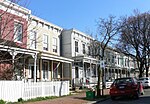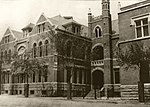Open High School (Virginia)
1972 establishments in VirginiaAlternative schools in the United StatesEducational institutions established in 1972High schools in Richmond, VirginiaMagnet schools in Virginia ... and 3 more
Public high schools in VirginiaUse mdy dates from January 2020Virginia school stubs
Open High School is an alternative public high school in urban Oregon Hill in Richmond, Virginia. It was established in 1972 with the intention of helping students become independent, self-determined thinkers and learners. Students volunteer at a variety of places, take college courses for high school and college credit, and independently develop and maintain a class schedule. The school building was originally built with money and on land donated by Grace Arents.
Excerpt from the Wikipedia article Open High School (Virginia) (License: CC BY-SA 3.0, Authors).Open High School (Virginia)
South Pine Street, Richmond Oregon Hill
Geographical coordinates (GPS) Address External links Nearby Places Show on map
Geographical coordinates (GPS)
| Latitude | Longitude |
|---|---|
| N 37.53769 ° | E -77.45088 ° |
Address
Open High School
South Pine Street 600
23220 Richmond, Oregon Hill
Virginia, United States
Open on Google Maps









